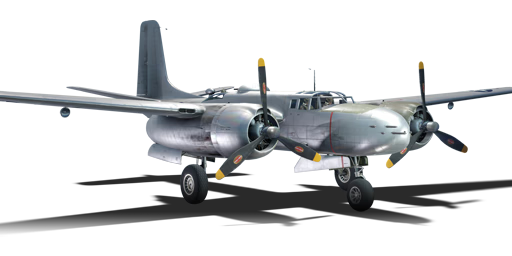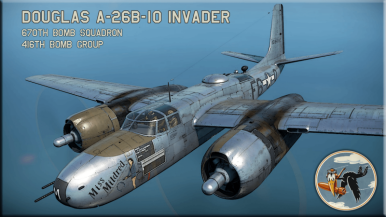



To capitalize on the export success of the A-20 Havoc, the Douglas Aircraft Company developed a successor attack aircraft design immediately after the Havoc entered service with the USAAC in 1941. What would become the A-26 Invader was designed as a mutirole light bomber and ground attack aircraft, with a distinctive interchangeable nose section that could either be equipped with a glass canopy for the bombardier position when used as a bomber (designated A-26C) or forward-facing guns of various calibres to attack ground targets (designated A-26B). After entering service in 1944, the Invader would go on to have a long and decorated career life up until the Vietnam War era thanks to its versatility. At one point, it was even redesignated as "B-26" when the unrelated B-26 Marauder was retired in 1946, which resulted in confusion between the two aircraft.
Introduced in Update 1.71 "New E.R.A.", the A-26B-10 is an excellent ground attack aircraft, boasting 6 nose-mounted M2 Browning .50 cal machine guns, as well as a potential payload of up to 4,000 lb worth of bombs (4 x 1,000 lb). The Invader also sports two dual-M2 Browning machine gun turrets, remote controlled by a gunner located in the rear section of the aircraft, that flawlessly track aircraft transitioning in the vertical. In addition, later upgrades of this particular A-26B model grant the user the ability to use a nose-mounted 37 mm M9 cannon, at the expense of two of the .50 cals, or even removing all .50 cals in favour of a pair of 37 mm cannons. The Invader's strength over many similar twin-engine aircraft is the surprising punch that it packs, especially when the 37 mm cannon is equipped, which can possibly turn the attacker into a fearsome, yet cumbersome blitzer due to its incredible speed.
flaps
flaps
flaps
brake
| Belt | Belt filling | Armor penetration (mm) at a distance: | |||||
|---|---|---|---|---|---|---|---|
| 10 m | 100 m | 500 m | 1000 m | 1500 m | 2000 m | ||
| API-T/AP/AP/I | 30 | 27 | 20 | 13 | 9 | 6 | |
| AP-I/AP-I/API-T/I/I | 28 | 26 | 18 | 11 | 7 | 4 | |
| API-T/I/AP/AP/AP-I/AP-I | 30 | 27 | 20 | 13 | 9 | 6 | |
| API-T | 28 | 26 | 18 | 11 | 7 | 4 | |
| AP-I/I/AP-I/I | 28 | 26 | 18 | 11 | 7 | 4 | |
| Belt | Belt filling | Armor penetration (mm) at a distance: | |||||
|---|---|---|---|---|---|---|---|
| 10 m | 100 m | 500 m | 1000 m | 1500 m | 2000 m | ||
| HEFI-T/AP-T | 76 | 72 | 54 | 38 | 27 | 19 | |
| HEFI-T/HEFI-T/AP-T | 76 | 72 | 54 | 38 | 27 | 19 | |
| AP-T | 76 | 72 | 54 | 38 | 27 | 19 | |
| HEFI-T | 7 | 6 | 5 | 4 | 3 | 3 | |
| Belt | Belt filling | Armor penetration (mm) at a distance: | |||||
|---|---|---|---|---|---|---|---|
| 10 m | 100 m | 500 m | 1000 m | 1500 m | 2000 m | ||
| HEFI-T/AP-T | 76 | 72 | 54 | 38 | 27 | 19 | |
| HEFI-T/HEFI-T/AP-T | 76 | 72 | 54 | 38 | 27 | 19 | |
| AP-T | 76 | 72 | 54 | 38 | 27 | 19 | |
| HEFI-T | 7 | 6 | 5 | 4 | 3 | 3 | |
| Belt | Belt filling | Armor penetration (mm) at a distance: | |||||
|---|---|---|---|---|---|---|---|
| 10 m | 100 m | 500 m | 1000 m | 1500 m | 2000 m | ||
| API-T/AP/AP/I | 30 | 27 | 20 | 13 | 9 | 6 | |
| AP/AP/AP/API-T | 30 | 27 | 20 | 13 | 9 | 6 | |
| AP-I/I/AP-I/API-T | 28 | 26 | 18 | 11 | 7 | 4 | |












Flight performance | |
|---|---|
Survivability |
|---|
Weaponry | ||
|---|---|---|
